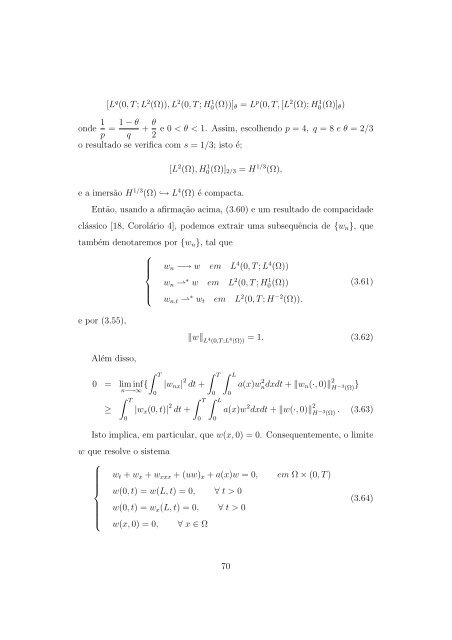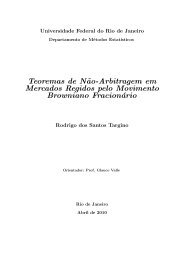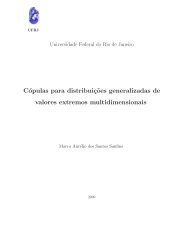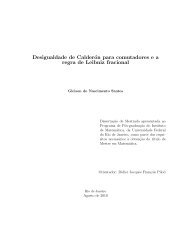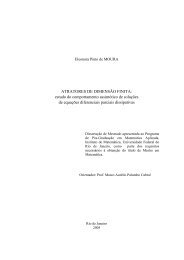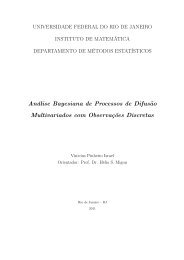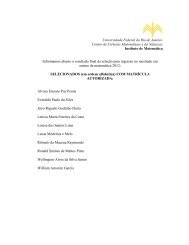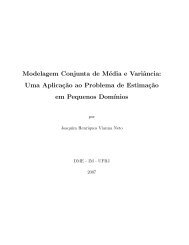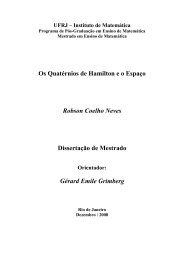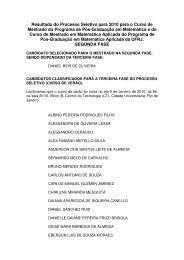Existência, Unicidade e Decaimento Exponencial das Soluç ... - UFRJ
Existência, Unicidade e Decaimento Exponencial das Soluç ... - UFRJ
Existência, Unicidade e Decaimento Exponencial das Soluç ... - UFRJ
You also want an ePaper? Increase the reach of your titles
YUMPU automatically turns print PDFs into web optimized ePapers that Google loves.
[L q (0, T ; L 2 (Ω)), L 2 (0, T ; H0(Ω))] 1 θ = L p (0, T, [L 2 (Ω); H0(Ω)] 1 θ )<br />
onde 1 p = 1 − θ + θ e 0 < θ < 1. Assim, escolhendo p = 4, q = 8 e θ = 2/3<br />
q 2<br />
o resultado se verifica com s = 1/3; isto é;<br />
[L 2 (Ω), H0(Ω)] 1 2/3 = H 1/3 (Ω),<br />
e a imersão H 1/3 (Ω) ↩→ L 4 (Ω) é compacta.<br />
Então, usando a afirmação acima, (3.60) e um resultado de compacidade<br />
clássico [18, Corolário 4], podemos extrair uma subsequência de {w n }, que<br />
também denotaremos por {w n }, tal que<br />
⎧<br />
w ⎪⎨ n −→ w em L 4 (0, T ; L 4 (Ω))<br />
w n ⇀ ∗ w em L 2 (0, T ; H0(Ω))<br />
1 (3.61)<br />
⎪⎩ w n,t ⇀ ∗ w t em L 2 (0, T ; H −2 (Ω)).<br />
e por (3.55),<br />
‖w‖ L 4 (0,T ;L 4 (Ω))<br />
= 1. (3.62)<br />
Além disso,<br />
∫ T<br />
0 = lim inf { |w nx | 2 dt +<br />
n−→∞<br />
≥<br />
∫ T<br />
0<br />
|w x (0, t)| 2 dt +<br />
∫ T ∫ L<br />
0<br />
∫ T ∫ L<br />
0<br />
0 0<br />
0<br />
a(x)w 2 ndxdt + ‖w n (·, 0)‖ 2 H −3 (Ω) }<br />
a(x)w 2 dxdt + ‖w(·, 0)‖ 2 H −3 (Ω) . (3.63)<br />
Isto implica, em particular, que w(x, 0) = 0. Consequentemente, o limite<br />
w que resolve o sistema<br />
⎧<br />
w t + w x + w xxx + (uw) x + a(x)w = 0, em Ω × (0, T )<br />
⎪⎨ w(0, t) = w(L, t) = 0, ∀ t > 0<br />
(3.64)<br />
w(0, t) = w x (L, t) = 0, ∀ t > 0<br />
⎪⎩ w(x, 0) = 0, ∀ x ∈ Ω<br />
70


